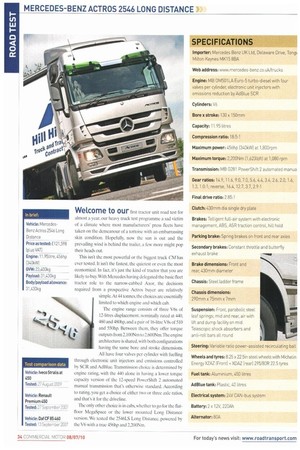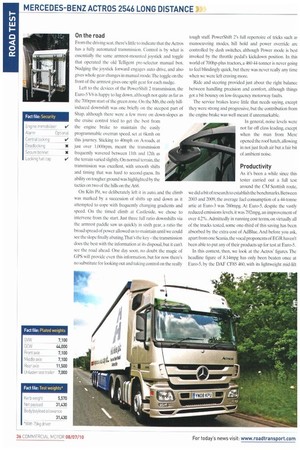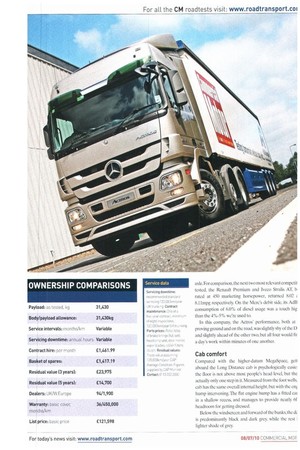dros 254
Page 33

Page 34

Page 36

Page 37

Page 38

If you've noticed an error in this article please click here to report it so we can fix it.
ong ustanc
Welcome to our first tractor unit road test for almost a year, our heavy truck test programme a sad victim of a climate where most manufacturers' press fleets have taken on the demeanour of a tortoise with an embarrassing skin condition. Hopefully, now the sun is out and the prevailing wind is behind the trailer, a few more might pop their heads out.
This isn't the most powerful or the biggest truck CM has ever tested. lt isn't the fastest, the quietest or even the most economical. in fact, it's just the kind of tractor that you are likely to buy With Mercedes having delegated the basic fleet tractor role to the narrow-cabbed Axor, the decisions required from a prospective Actros buyer are relatively simple. At 44 tonnes, the choices are essentially limited to which engine and which cab.
The engine range consists of three V6s of 12-litres displacement. nominally rated at 440, 460 and 480hp, and a pair of 16-litre V8s of 510 and 550hp. Between them, they offer torque outputs from 2.100Nm to 2.600Nm.The engine architecture is shared, with both configurations having the same bore and stroke dimensions All have four valves per cylinder with fuelling through electronic unit injectors and emissions controlled by SCR and Ad Blue, Transmission choice is determined by engine rating, with the 440 alone in having a lower torque capacity version of the 12-speed PowerShift 2 automated manual transmission that's otherwise standard. According to rating, you get a choice of either two or three axle ratios and that's it for the driveline.
The only other choice is in cabs, whether to go for the flatfloor MegaSpace or the lower mounted Long Distance version. We tested the 25461S Long Distance, powered by the V6 with a true 456hp and 2200Nm.
On the road
From the driving seat, there's little to indicate that the Actros has a fully automated transmission. Control is by what is essentially the same armrest-mounted joystick and toggle that operated the old Telligent pre-selector manual box. Nudging the joystick forward engages auto drive, and also gives whole gear changes in manual mode. The toggle on the front of the armrest gives one split gear for each nudge.
Left to the devices of the PowerShift 2 transmission, the Euro-5 V6 is happy to lug down, although not quite as far as the 700rpm start of the green zone. On the M6, the only hillinduced downshift was one briefly on the steepest part of Shap. although there were a few more on down-slopes as the cruise control tried to get the hest from the engine brake to maintain the easily programmable oven-un speed, set at 6kmh on this journey. Sticking to 40mpli on A-roads, at just over 1,000rpm, meant the transmission frequently wavered between I 1 th and 12th as the terrain varied slightly. On normal terrain, the transmission was excellent, with smooth shifts and timing that was hard to second-guess. Its ability on tougher ground was highlighted by the tacties on two of the hills on the A68.
On Kiln Pit, we deliberately left it in auto, and the climb was marked by a succession of shifts up and down as it attempted to cope with frequently changing gradients and speed. On the timed climb at Castleside. we chose to intervene from the start. Just three full ratio downshifts via the armrest paddle saw as quickly in sixth gear, a ratio the broad spread of power allowed us to maintain until we could see the slope finally abating.That's the key — the transmission does the best with the information at its disposal, but it can't see the road ahead. One day soon, no doubt the magic of GPS will provide even this information, but for now there's no substitute for looking out and taking control on the really tough stuff. PowerShift 2's full repertoire of tricks such a5 manoeuvring modes, hill hold and power override arc controlled by dash switches. although Power mode is best invoked by the throttle pedal's kickdown position. In this world of 700hp-plus tractors, a 460 44-tonner is never going to feel blindingly quick. but there was never really any time when we were left craving more.
Ride and steering provided just about the right balance between handling precision and comfort, although things got a bit bouncy on low-frequency motorway faults.
The service brakes leave little that needs saying, except they were strong and progressive, but the contribution from the engine brake was well meant if unremarkable.
In general. noise levels were not far off class leading. except when the man front Mere opened the roof hatch, allowing in not just fresh air but a fair bit of ambient noise.
Productivity As it's been a while since this tester carried out a full test around the CM Scottish route, we did a bit of research to establish the benchmarks. Between 2003 and 2009, the average fuel consumption of a 44-tonne artic at Euro-3 was 7.60mpg. At Euro-5, despite the vastly reduced emissions levels, it was 7.92mpg, an improvement of over 4.2%. Admittedly in running cost terms, on virtually all of the trucks tested, some one-third of this saving has been absorbed by the extra cost of AdBlue. And before you ask, apart from one Scania, the vocal proponents of EGR haven't been able to put any of their products up for test at Euro-5.
In this context, then, we look at the Actros* figures. The headline figure of 8.14mpg has only been beaten once at Euro-5, by the DAF CF85 460, with its lightweight mid-lift
axle. For comparison, the next two most relevant compet it tested. the Renault Premium and Iveco Stralis AT. b rated at 450 marketing horsepower, returned 8.02 8.11mpg respectivelv. On the Merc's debit side, its AdB consumption of 6.0% of diesel usage was a touch hig than the 4%-5% we're used to.
In this company. the Actros' performance, both at proving ground and on the road, was slightly shy of the D and slightly ahead of the other two, but all four would fir a day's work within minutes of one another.
Cab comfort Compared with the higher-datum MegaSpace, gelt aboard the Long Distance cab is psychologically easiei the floor is not above most people's head level, but the actually only one step in it. Measured from the foot wells, cab has the same overall internal height, but with the enE hump intervening. The fiat engine hump has a fitted cal in a shallow recess, and manages to provide nearly ôf headroom for getting dressed.
Below the wind.screen and forward of the bunks, the ck is predominantly black and dark grey. while the rest i lighter shade of grey. Two high-spec Grammer air seats provide the on-duty accommodation.The instrument panel is the usual Mercedes model of clarity. and incorporates a very comprehensive trip com pule r.The familiar chunky column stalks control lighting and screen wiping on the left, and engine brake and cruise control on the right. The driver's workload is reduced even further than usual with automatic lights as standard, and rain sensing wipers as an option. Most secondary switches are within easy reach of the driver's left hand. with a few more above the screen near the radio/CD player. with Bluet000th connectivity, and tachograph. One unfamiliar dash badge is for that essential accessory. the illuminated Mercedes star on the grille. Few drivers working in the UK will be left wanting for storage space. The main storage is provided by three big lockers and two smaller bins above the screen. A large side-out drawer is conveniently located under the central bunk, just right tor storing provisions, and it has a folding table ready for mealtimes or paperwork sessions. The outer ends beneath the bunk house a pair of lockers with internal and external access. There's another smaller drawer below the centre of the dash, just big enough for A4 documents, and a whole host of minor storage spots around the dash. Both occupants get three drinks holders each, two on the dash and one in the door pocket. there are three auxiliary power sockets on the dash. including one at 12V, and a flat tray on the central dash top is a good spot for the evening's entertainment hardware.
Two bunks are fitted, the upper one normally held up at 45 degrees revealing a large MB logo. This limits use of the lower bunk as a seat — the longer your back, the worse the crick in your neck is going to be. Sleeping promises more comfort, though, as both bunks are of the orthopedicallyapproved Lattollex slat design. To create more room around the lower bunk, the passenger seat backrest can be tilted forward by releasing a catch at its inner top edge. There's a safety net for upstairs, but if you really worry about rolling out, or are parked up for the night pointing downhill, the bunk's angle is easily adjustable.
A comprehensive control panel is provided in the lower bunk area, covering night heater master, radio volume, roof hatch and interior lights, and beneath this is the alarm clock unit.There's plenty of trinket space at upper bunk level, and a smoke detector.lhe roof hatch is flanked by a pair of bars that double as grab handles for the top bunk and towel rails. Visibility is good and although the large mirrors create equally large blind spots. the gap to the A-pillar is sufficiently wide to see around with a bit of head movement. The front view mirror is sensibly located within the cab's width, protecting it in tight spots without affecting its functionality 'Ille driver's side vision is protected from the sun by a roller blind, with conventional visors to the front. The long distance cab offers a less commanding view than the MegaSpace. but this only prevents nosey drivers from looking over the highest fences. •




























































































































